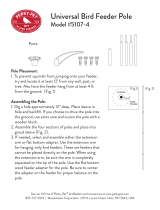Page is loading ...

Bird feeders are an
excellent way to attract
a bevy of birds to your
property. There are a
variety of feeders to
accommodate specific
types of birds and their
diets. Birds usually feed
at different heights, and
having multiple feeders
will not only attract a
variety of species, it will
also help avoid feeder
congestion. When placing
feeders close to windows
so that you can enjoy the
action, be aware that large
picture windows may
result in collisions. Here are
Audubon’s picks for six
feeders, and a little advice
on where to hang them.
Audubon Guide
to Bird Feeders
BIRD FEEDING BASICS
225 Varick Street
New York, NY 10014
844.428.3826
Written by Stephen W. Kress, PhD
Photography by Mike Fernandez/Audubon
Visit Audubon online for
more information and tips on
creating a bird-friendly yard.
www.audubon.org
About Audubon
The National Audubon Society protects birds and the
places they need, today and tomorrow. Audubon works
throughout the Americas using science, advocacy,
education, and on-the-ground conservation. State
programs, nature centers, chapters, and partners
give Audubon an unparalleled wingspan that reaches
millions of people each year to inform, inspire, and unite
diverse communities in conservation action. A nonprofit
conservation organization since 1905, Audubon believes
in a world in which people and wildlife thrive.

GROUND FEEDERS
These simple screen-
bottomed trays typically sit
several inches o the ground
or your deck and help to
keep grain or seeds and bird
droppings from coming in
contact with each other.
Some feeders have covers
to keep out snow; others
have wire mesh to keep out
squirrels and large birds
like crows. Ground feeding
tables should be placed in
open areas at least 10 feet
from the nearest tree or
shrub to give birds a chance
to flee predators. Doves,
juncos, sparrows, towhees,
goldfinches, and cardinals
are all likely to visit ground
feeders. Avoid using ground
feeders if cats are apt to
pounce from nearby shrubs.
Six bird feeders every home should have
SUET FEEDERS
Suet is popular with titmice,
chickadees, nuthatches,
and woodpeckers. Wrens,
creepers, and warblers will
also occasionally peck at
suet. While you can hang
suet chunks in a mesh onion
bag, you can also purchase
cage feeders. Some people
like to make their own suet
“puddings” by grinding
the suet and adding seeds,
and create homemade suet
feeders by packing the
mixture into the crevices
of large pine cones. Suet
feeders can be hung from
trees, from poles near other
feeders, or from a wire
stretched between trees.
Also available for warm
weather suet feeding are
“no melt” suet cakes.
NYJER® (THISTLE)
FEEDERS
Especially designed to
dispense Nyjer® seed, also
known as thistle seed, these
feeders have tiny holes that
make the seed available only
to small-beaked finches such
as goldfinches, redpolls, and
Pine Siskins. Thistle-seed-
dispensing bags are not
recommended, since squirrels
can easily tear holes in them
and waste this expensive
seed. Hang your thistle
feeder from a tree or place
it on a five-foot pole near
other feeders, taking care to
protect it from squirrels with
a special bae.
SUNFLOWER SEED
TUBE FEEDERS
If you are going to put out
just one feeder, this is your
best choice. Be sure to
select a model with metal
ports around the seed
dispensers to protect the
feeder from House Sparrows
and nibbling squirrels. Hang
the feeder at least five feet
o the ground and try to
position it near a window
where you can enjoy the
visitors, which are likely to
include chickadees, titmice,
nuthatches, goldfinches,
siskins, and Purple and
House Finches. Reduce the
risk of bird collisions by
placing the feeder less than
three feet from a window
or more than 30 feet away.
HOPPER FEEDERS
Hopper feeders will keep
several pounds of mixed
seed dry and ready for
hungry birds. Birds hopping
on the feeder trigger the
release of the seeds. Hopper
feeders should be positioned
on a pole about five feet
o the ground, or hung
from a tree branch. They
will draw all the species
that tube feeders attract,
along with larger birds like
jays, grackles, Red-winged
Blackbirds, and cardinals.
NECTAR AND FRUIT
FEEDERS
Nectar feeders will help
attract hummingbirds,
orioles, and other nectar-
eating birds to your garden
until your garden flowers
are flourishing. To prepare a
sugar water solution, mix one
part white sugar with four
parts water. Bring the mixture
to a boil to sterilize it and
dissolve all of the sugar. Clean
feeders every two or three
days under hot running tap
water, scrubbing them with
a bottlebrush to eliminate
molds or fungus. Tie a cluster
of plastic red flowers over
the feeder entrance to help
attract hummingbirds to
new feeders. Lure orioles
and tanagers by skewering
halved oranges onto a spike.
BIRD FEEDING BASICS
/










